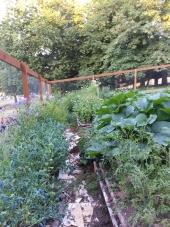


Clean With Cleaners You Can Eat by Raven Ranson
will be released to subscribers in:
soon!



 14
14




Success has a Thousand Fathers , Failure is an Orphan
LOOK AT THE " SIMILAR THREADS " BELOW !
 15
15




"We're all just walking each other home." -Ram Dass
"Be a lamp, or a lifeboat, or a ladder."-Rumi
"It's all one song!" -Neil Young












 3
3




Check out Redhawk's soil series: https://permies.com/wiki/redhawk-soil
 1
1




 1
1




Check out Redhawk's soil series: https://permies.com/wiki/redhawk-soil




Eva








"Permaculture is a philosophy of working with, rather than against nature; of protracted & thoughtful observation rather than protracted & thoughtless labour; & of looking at plants & animals in all their functions, rather than treating any area as a single-product system."-Bill Mollison










Success has a Thousand Fathers , Failure is an Orphan
LOOK AT THE " SIMILAR THREADS " BELOW !














Success has a Thousand Fathers , Failure is an Orphan
LOOK AT THE " SIMILAR THREADS " BELOW !




We are all connected, all life is universal. Permaculture helps us embrace this through direct action, solutions for everyone. http://www.permatees.com






 1
1




Success has a Thousand Fathers , Failure is an Orphan
LOOK AT THE " SIMILAR THREADS " BELOW !




My project thread
Agriculture collects solar energy two-dimensionally; but silviculture collects it three dimensionally.
 2
2


















"Never doubt that a small group of thoughtful, committed citizens can change the world; indeed, it's the only thing that ever has."-Margaret Mead "The only thing worse than being blind, is having sight but no vision."-Helen Keller
 3
3














 1
1




"Never doubt that a small group of thoughtful, committed citizens can change the world; indeed, it's the only thing that ever has."-Margaret Mead "The only thing worse than being blind, is having sight but no vision."-Helen Keller
 2
2














 3
3




"Never doubt that a small group of thoughtful, committed citizens can change the world; indeed, it's the only thing that ever has."-Margaret Mead "The only thing worse than being blind, is having sight but no vision."-Helen Keller




 3
3








 1
1












 2
2














 1
1




Yikes. perhaps I should stop picking boletus? Are other fungi potentially sequestering radioactive compounds? Also, when I think of the word forensic, I think science for the purpose of deducing crime. When I think Cesium, I think Fukushima. Are you seeing the nuclear disaster as a criminal act?nowadays the gaze is forensic: the pigments of Boletus, for example, can sequester 137-cesium.
I'm quite familiar with the Mountain Pine Beetle epidemic and it's fungal connection in my province, but not the California statistics. In B.C., those numbers would be rather small, I would think.We may as well mention that bark beetles can transmit fungal pathogens to trees. Is this correct: 29 million dead in California?
"Never doubt that a small group of thoughtful, committed citizens can change the world; indeed, it's the only thing that ever has."-Margaret Mead "The only thing worse than being blind, is having sight but no vision."-Helen Keller

|
Whose rules are you playing by? This tiny ad doesn't respect those rules:
The new kickstarter is now live!
https://www.kickstarter.com/projects/paulwheaton/garden-cards
|








